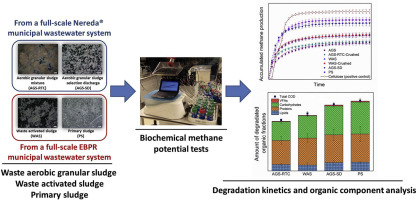当前位置:
X-MOL 学术
›
Water Res.
›
论文详情
Our official English website, www.x-mol.net, welcomes your feedback! (Note: you will need to create a separate account there.)
Digestibility of waste aerobic granular sludge from a full-scale municipal wastewater treatment system.
Water Research ( IF 12.8 ) Pub Date : 2020-02-12 , DOI: 10.1016/j.watres.2020.115617 Hongxiao Guo 1 , Jules B van Lier 1 , Merle de Kreuk 1
Water Research ( IF 12.8 ) Pub Date : 2020-02-12 , DOI: 10.1016/j.watres.2020.115617 Hongxiao Guo 1 , Jules B van Lier 1 , Merle de Kreuk 1
Affiliation

|
Full-scale aerobic granular sludge technology under the trade name Nereda® has been implemented for municipal, as well as industrial wastewater treatment. Owing to the operational reactor procedures, two types of waste aerobic granular sludge can be clearly distinguished: 1) aerobic granular sludge selection discharge (AGS-SD) and 2) aerobic granular sludge mixture (AGS-RTC). This study systematically compared the anaerobic biodegradability of AGS-SD and AGS-RTC under mesophilic conditions. Results were further compared with the anaerobic conversion of waste activated sludge (WAS) as well as primary sludge (PS) from full-scale municipal wastewater treatment plants. Analysis showed similar chemical characteristics for AGS-SD and PS, which were both characterized by a high carbohydrate content (429 ± 21 and 464 ± 15 mg glucose/g VS sludge, respectively), mainly cellulosic fibres. Concurrently, AGS-RTC exhibited chemical properties close to WAS, both characterized by a relatively high protein content, which were individually 498 ± 14 and 389 ± 15 mg/g VS sludge. AGS-SD was characterized by a high biochemical methane potential (BMP) (296 ± 15 mL CH4/g VS substrate), which was similar to that of PS, and remarkably higher than that of AGS-RTC and WAS. Strikingly, the BMP of AGS-RTC (194 ± 10 mL CH4/g VS substrate) was significantly lower than that of WAS (232 ± 11 mL CH4/g VS substrate). Mechanically destroying the compact structure of AGS-RTC only accelerated the methane production rate but did not significantly affect the BMP value. Results indicated that compared to WAS, the proteins and carbohydrates in AGS-RTC were both more resistant to anaerobic bio-degradation, which might be related to the presence of refractory microbial metabolic products in AGS-RTC.
中文翻译:

大规模市政污水处理系统产生的好氧颗粒污泥的消化率。
商标为Nereda®的全尺寸好氧颗粒污泥技术已应用于市政以及工业废水处理。由于反应器的运行程序,可以清楚地区分两种类型的废弃好氧颗粒污泥:1)好氧颗粒污泥选择排放(AGS-SD)和2)好氧颗粒污泥混合物(AGS-RTC)。这项研究系统地比较了中温条件下AGS-SD和AGS-RTC的厌氧生物降解性。将结果与全规模市政废水处理厂的废活性污泥(WAS)和初级污泥(PS)的厌氧转化进行了比较。分析显示,AGS-SD和PS的化学特性相似,均以高碳水化合物含量(429±21和464±15 mg葡萄糖/ g VS污泥,分别),主要是纤维素纤维。同时,AGS-RTC表现出接近WAS的化学特性,两者均具有相对较高的蛋白质含量,分别为498±14和389±15 mg / g VS污泥。AGS-SD的特征是具有较高的生化甲烷潜力(BMP)(296±15 mL CH4 / g VS底物),与PS相似,并且显着高于AGS-RTC和WAS。令人惊讶的是,AGS-RTC的BMP(194±10 mL CH4 / g VS底物)显着低于WAS(232±11 mL CH4 / g VS底物)。机械破坏AGS-RTC的紧凑结构只会加快甲烷生成速度,但不会显着影响BMP值。结果表明,与WAS相比,AGS-RTC中的蛋白质和碳水化合物对厌氧生物降解的抵抗力更高,
更新日期:2020-02-12
中文翻译:

大规模市政污水处理系统产生的好氧颗粒污泥的消化率。
商标为Nereda®的全尺寸好氧颗粒污泥技术已应用于市政以及工业废水处理。由于反应器的运行程序,可以清楚地区分两种类型的废弃好氧颗粒污泥:1)好氧颗粒污泥选择排放(AGS-SD)和2)好氧颗粒污泥混合物(AGS-RTC)。这项研究系统地比较了中温条件下AGS-SD和AGS-RTC的厌氧生物降解性。将结果与全规模市政废水处理厂的废活性污泥(WAS)和初级污泥(PS)的厌氧转化进行了比较。分析显示,AGS-SD和PS的化学特性相似,均以高碳水化合物含量(429±21和464±15 mg葡萄糖/ g VS污泥,分别),主要是纤维素纤维。同时,AGS-RTC表现出接近WAS的化学特性,两者均具有相对较高的蛋白质含量,分别为498±14和389±15 mg / g VS污泥。AGS-SD的特征是具有较高的生化甲烷潜力(BMP)(296±15 mL CH4 / g VS底物),与PS相似,并且显着高于AGS-RTC和WAS。令人惊讶的是,AGS-RTC的BMP(194±10 mL CH4 / g VS底物)显着低于WAS(232±11 mL CH4 / g VS底物)。机械破坏AGS-RTC的紧凑结构只会加快甲烷生成速度,但不会显着影响BMP值。结果表明,与WAS相比,AGS-RTC中的蛋白质和碳水化合物对厌氧生物降解的抵抗力更高,



























 京公网安备 11010802027423号
京公网安备 11010802027423号